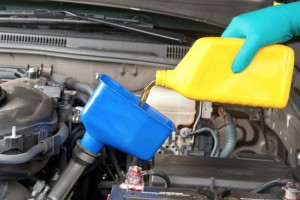
Checking lubricants and fluids are part of the preventative maintenance routine recommended in the spring, according to experts.
Most of the nation has shaken off the yoke of winter and spring is upon us, which means its time to live the famous refrain, April showers bring … potholes and rain mostly.
April not only marks the beginning of spring, but also National Car Care month. It’s the time of the year that motorists need to focus on replacing windshield wiper blades, check the air pressure in tires and to ensure brakes are safe and working properly, according to the Car Care Council.
The council says that cars inspected between April and October 2014 revealed that 84% of vehicles need service or parts, up 5% from the previous year.
“Neglected vehicle care almost always means much higher costs down the line in the form of more extensive repairs or lost resale value,” said Rich White, executive director, Car Care Council. “These results show that the majority of vehicle owners could save money by being proactive in the maintenance of their second-largest investment.”
So if you’re part of the 46% of Americans that are confident in performing regular car maintenance tasks such as changing oil, spark plugs and air filters, according to Hankook Tire’s quarterly gauge index, now is the time to perform those tasks. Otherwise turn those tasks over to a mechanic.
Hankook believes that shouldn’t be a problem as 72% of the people surveyed still rely on a mechanic they trust to maintain and give advice about their car.
What should a good spring maintenance check involve? Checking lubricants, fluids, filters, belts, hoses, wipers, lights, brakes and tires. Many of these get checked during a routine oil change.
The council said that during its inspections of lubricants and fluids, the three top failure rates were: low washer fluid at 27%; low or dirty motor oil at 25%; and low, leaky or dirty coolant at 17%. When checking under the hood, nearly one in five vehicles needed a new air filter.
(Your next GM car might warn you before it breaks down. For more, Click Here.)
At least one belt was reported as unsatisfactory in 17% of the vehicles inspected, and 8% required at least one new hose. Other common “under hood” issues involved the battery: loose battery cables and clamps, dirty terminals needed maintenance and batteries were not properly held down.
(Click Here for details about the auto safety features Americans want.)
Approximately 16% of vehicles had front windshield wiper failures, and at least 11% of vehicles needed lights replaced, including headlights, brake lights and license plate lights. Improperly inflated tires were found on 10% of the cars, and 14% had worn tread and were in need of replacement.
(To see more about how dealers are taking the sting out of recalls, Click Here.)
It’s the tires that often cause drivers the most grief. The aforementioned potholes often seem to get large enough to swallow a Ford Fiesta, but more importantly, hitting one square can mean a flat tire. So knowing how to change a tire – as 52% of those in the Hankook survey say they can do – is a good thing. Checking the manual of your vehicle to find out how to release the spare, making sure it’s inflated and ensuring all of the tools you’ll need are actually in your vehicle are important. If you can’t change a tire, then making sure you have phone numbers for roadside assistance handy is equally important.

Amazingly most U.S. consumers have never read their new car owner’s manual. Most folks can not change a tire. Most folks don’t know what the proper specification oil is for their engine and many don’t know how to even check the engine oil level, (if there is no dash indicator).
As a society we are pretty technically challenged and rely on others to guide us yet most any person from the age of eight years old has a cellphone… This illustrates where people’s priorities are in the U.S.